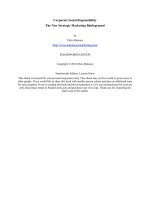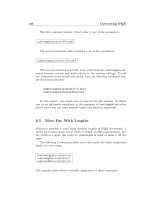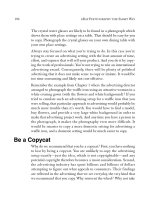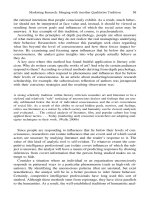Qualitative Research in Intelligence and Marketing: The New Strategic Convergence phần 10 pot
Bạn đang xem bản rút gọn của tài liệu. Xem và tải ngay bản đầy đủ của tài liệu tại đây (118.43 KB, 27 trang )
The Qualitative Audit 221
If employees do not stay with an organization for long periods of time, the organi-
zation will not be willing to invest heavily in them.
4. Do clients feel that competitive intelligence is a set of techniques that can be routinely
applied to any project at hand?
Although competitive intelligence is a complicated profession, this fact might not be
obvious to the client. If the client does not recognize the distinctiveness of competitive
intelligence, it might appear that anyone with minimal computer savvy can perform
the basic tasks of competitive intelligence professionals. If so, the client and organ-
ization will probably not be willing to invest heavily in competitive intelligence an-
alysts.
5. Does the organization believe that providing analysts with specific and long-term
exposure to the subjects they research is a legitimate and expected cost of business?
If the organization believes that its interests are served by providing long-term and
specialized training to analysts, it will be willing to invest. Without this belief, it will
not be willing to do so.
Not all organizations are willing to invest in analysts in ways that allow them
to gain the expertise they need to most effectively do their job. Because com-
petitive intelligence involves applying intuitive and subjective analysis to a di-
verse data set, analysts need a long-term and sophisticated exposure to the
phenomena they analyze. Unfortunately, some organizations are not willing to
provide this support. When organizations do not, the competitive intelligence
function suffers and their product degenerates.
The responsiveness of clients and organizations to qualitative methods,
therefore, is a key issue that needs to be considered. Competitive intelligence
professionals do not live and work in isolation. What they do and how they do
it will be closely tied to the orientations of their organizations and clients.
INTERCONNECTEDNESS OF BOTH
While the two measures discussed above—(1) skills of analysts and (2) re-
spect of clients—are independent, they are closely interconnected. Thus, if cli-
ents have little respect for qualitative methodologies, the people that the
organization has hired in the past will probably not be particularly strong in that
regard. As a result, clients who have never been offered professional qualitative
analytic services will probably not think of using them, and analysts who are
seldom allowed to employ qualitative methods will not develop sophisticated
expertise in that area; the cycle goes on.
This is a cycle, however, that needs to be broken. Competitive intelligence
staffs need to develop their qualitative toolkits and clients need to make use of
qualitative methods when they are appropriate. If not, both the competitive in-
telligence function and its clients will suffer.
222 Operationalizing the Social Sciences and the Humanities
HIRING NEW STAFF AFTER AN AUDIT
Having completed a qualitative audit, it should be possible to assess if there
is a need to acquire additional qualitative skills by hiring individuals with qual-
itative expertise. In addition, the audit should provide a “feel” for the organi-
zation and the degree to which qualitative methods will be treated with respect.
Ideally, adding new staff members with qualitative skills should be done in
tandem with efforts to help clients to recognize the benefits to be derived from
qualitative methods. Hiring humanists and social scientists with the required
abilities should be fairly easy because many skilled candidates with advanced
training are underemployed. The “care and feeding” of these atypical recruits,
however, may be a challenge for those who usually deal exclusively with busi-
ness school graduates and/or veterans of the private sector. Nonetheless, the
rewards of doing so can be many.
UPGRADING STAFF AFTER AN AUDIT
“Upgrading staff” means taking the existing analysts and helping them to
gain the skills they need in order to more effectively employ qualitative methods.
Some of this upgrading may include academic work. In business schools, grad-
uate courses in consumer research and marketing research may be particularly
useful. If courses on qualitative methods exist, they will be particularly appro-
priate. Other disciplines (such as education departments) are also striving to
embrace qualitative methods and they might offer courses on qualitative tech-
niques.
Analysts may also want to go straight to the qualitative disciplines. An an-
thropological methods course would be a logical choice. Various seminars in
the theory and methods of disciplines such as literary criticism would be appro-
priate. The fields of American studies and popular culture will also provide much
useful information and valuable techiques.
The goal here is to upgrade the qualitative skills of researchers in order to
take full advantage of qualitative techniques. In many organizations, qualitative
methods have not been emphasized. As a result, the qualitative skills of analysts
who work within such organizations have, no doubt, atrophied. Nonetheless,
these are proven professionals and they may merely need an injection of state-
of-the-art qualitative methods to return to peak form.
CONCLUSION
In order for competitive intelligence professionals to understand the degree
to which qualitative methods are a vital part of the organization, assessing an-
alysts’ skills and determining the degree to which the organization respects qual-
itative methods must be considered. By addressing these questions, it is possible
The Qualitative Audit 223
to conduct a qualitative audit that measures the situation within a particular
organizational setting.
Once the audit is conducted (formally or informally), analysts will be in a
position to plan a course of action that may include upgrading skills and groom-
ing clients so they can better appreciate the benefits of qualitative research.
REFERENCE
Eddy, Elizabeth M. and Partridge, William L. (1978). Applied Anthropology in America.
New York: Columbia University Press.
Epilogue: The 10 Percent Edge
Qualitative methods in business will probably always constitute but a fairly
small percentage of the total research efforts which are conducted when seeking
to understand customers, competitors, and collaborators. These statistics, how-
ever, should not lull us into underestimating the importance of qualitative re-
search. Due to the fact that qualitative research is often not appropriately and
professionally pursued, its relevant and strategic use can easily emerge as the
“wild card” of competitive effectiveness.
Most organizations are skilled in gathering and assessing scientific and quan-
titative data. As a result, these tools, being universally available, do not provide
a distinctive competitive edge to those who have mastered them. Although the
organization may be handicapped if it lacks scientific and quantitative research
skills, it will also be at a disadvantage if it has not mastered qualitative methods.
Organizations that are skilled at using qualitative methods, however, may find
that they do enjoy a distinct advantage because many of their competitors, cus-
tomers, and collaborators have not learned to use these techniques and, therefore,
they will not be in a position to benefit from the insights they offer.
The reader may rebut that qualitative intelligence may only account for 10
percent of the data that is used to make decisions, but if an athlete loses a
footrace by a 10 percent margin, the defeat is devastating. The same is true of
strategists who miss 10 percent of the information that they need when making
decisions.
Appendix 1
The Use and Abuse of Warfare
and Sports Analogies
Warfare and sports analogies are among the most seductive metaphors used in
the business world. The basic orientation of these illusions is to equate the
conflicts an organization faces with warfare and athletic competition. In terms
of game theory, warfare and sports constitute what may be considered to be
“zero-sum games”; the goal is victory and the only way to achieve it is for the
competitor to lose.
Certainly, circumstances exist where the zero-sum game model legitimately
depicts the relationship between an organization and its competitors, and many
occasions exist where warfare and sports analogies that are hinged around win-
ning and losing are appropriate analogies by which an organization can view
itself and its predicament.
Many organizational leaders, furthermore, are comfortable being compared to
military warlords or sports heroes, and the strategies of combat may parallel the
tactics that businesses use when they struggle with competitors. Certainly, war-
fare and sports analogies have their uses.
Nonetheless, these analogies can be abused or overworked. A basic limitation
of warfare and sports analogies is that they draw attention away from the fact
that, strategically, organizations basically exist to serve, not to compete. Provid-
ing goods and services that customers and clients want is the most essential
essence of strategy; other decisions are, in the final analysis, tactical. Organi-
zations and their leaders need to remember this profound truth.
It is useful to juxtapose the warfare/sports analogy with the perspectives
(stemming from marketing) that organizations exist, primarily, to serve. Focus-
ing around clients or customers draws attention to the most basic strategic de-
cisions that organizations must make. In addressing this perspective, specific
issues need to be discussed. They include:
228 Appendix 1
1. The Nature of Strategy
2. The Primary Goals of Organizations
3. The Key Tactic Used to Achieve the Strategy
4. Measures of Success
In the discussions to follow, the warfare/sports paradigm will be juxtaposed with
marketing perspectives that center upon service, not competition.
THE NATURE OF STRATEGY
Those who embrace warfare/sports analogies think of strategy in terms of
competing against a rival. To these people, competition is the main strategic
consideration. The main focus is on defeating others.
To those who are primarily influenced by marketing, the most basic strategy
of the organization is serving others. Certainly, the organization may face com-
petition. Confronting rivals and competitors is a very real activity; doing so
must be pursued in conscious and forceful ways. Nonetheless, according to
marketing theory, the essence of strategy revolves around service, not compe-
tition.
THE PRIMARY GOALS OF ORGANIZATIONS
According to the warfare/sports analogy, the primary goal is to compete for
profits (that are equated with victory). Profits are viewed as the major purpose
for competition, just as winning is the primary purpose of playing a game or
fighting a war. According to these perspectives, the success of the organization
is measured in terms of successfully confronting others.
According to marketing theory, the purpose of an organization is to serve.
The better an organization serves its chosen target market, the more effective it
is, and effective organizations tend to enjoy profits. Thus, according to market-
ing, profits (the underlying goal driving the organization) are actually a bene-
ficial side effect of service. By providing legitimate service at a fair price, profits
accrue; thus, profits are tangible evidence of a job well done. This vision of
organizational effectiveness is not primarily based on conflict, but is keyed to
providing service in cooperative and mutually beneficial ways.
Indeed, in many cases, organizations systematically seek to avoid conflict.
Thus, an organization may choose not to compete against a potential rival and,
instead, respond to the needs of a target market that is not presently being
adequately served by anyone else. In these cases, conflict is overtly avoided and
the organization relies primarily upon providing service in order to achieve its
goals.
By transcending the warfare/sports analogy and by embracing the marketing
Appendix 1 229
perspective, competitive intelligence professionals can most effectively embrace
the modern philosophy of business that service is the key to success.
THE KEY TACTIC USED TO ACHIEVE THE STRATEGY
According to warfare/sports analogies, the key tactic organizations use is to
actively and forcefully compete against rivals. By competing, organizations seek
to become more effective and to win business at the expense of rivals. According
to this metaphor, the most successful organization wins because it competes
more effectively. Although marketers recognize that competition may take place,
marketing theory focuses primarily on providing customers and clients with
sought-after options. All strategists need to acknowledge both the threats and
weaknesses of their competitors and the wants and preferences of their custom-
ers/clients. Nonetheless, those who embrace the warfare/sports analogy concen-
trate on competition while those influenced by marketing view service as
primary. In many ways the popular warfare/sports analogy, seductive though it
may be, draws attention away from the importance of service and it can emerge
as counterproductive for that reason.
Organizations exist, basically, to serve customers and clients. As a result,
paradigms that focus on service should underlie the most basic strategies and
tactics of organizations.
MEASURES OF SUCCESS
Those who embrace the warfare/sports metaphor measure success and failure
in terms of how well organizations compete against rivals. Assuming that the
fact of winning implies that someone else has to lose, victory and defeat are
seen to be linked in inevitable ways.
According to marketing theory, success is measured in terms of service, not
victory. Marketers believe that all stakeholders should benefit from an exchange.
According to this perspective, the key relationship is not competition, but in-
volves cooperation and mutual benefits that accrue to all involved parties. Thus,
marketers measure success in terms of service while the warfare/sports analogy
thinks in terms of successful competition against a rival.
These considerations are depicted in Table A1.1.
For a number of reasons, warfare and sports analogies are very popular within
the business world. This popularity stems, in part, from the fact that organiza-
tions often are in conflict. In addition, leaders and decision makers find analogies
that are based on sports and military leaders to be attractive.
Useful though the warfare/sports analogy may be, it draws attention away
from the fact that organizational strategy basically seeks to provide services to
customers and clients. Everything else, ultimately, is a tactic. It is hoped that
competitive intelligence professionals will keep this fact in mind when negoti-
ating with clients and pursuing analysis.
230 Appendix 1
Table A1.1
Warfare/Sports versus Marketing Paradigms
Appendix 2
The “Care and Feeding”
of Humanists
A basic theme of this book is that the qualitative tools, techniques, and per-
spectives that stem from the social sciences and humanities have a significant
contribution to make to competitive intelligence. Earlier, it was mentioned that,
in the case of humanists, many well-trained professionals are unemployed or
underemployed; as a result, recruiting candidates with the appropriate skills and
areas of specialization is a realistic goal.
Nonetheless, humanists tend to be very different from job candidates and
employees who are products of practitioner-oriented disciplines (such as busi-
ness and the social sciences); although candidates from the humanistic disci-
plines may have the skills and knowledge that are required to be of service to
the competitive intelligence profession, they may not possess the temperament
and/or personal style that are required for effective involvement within the pri-
vate sector. Because humanists tend to be different from typical private sector
employees, strategies of recruitment and motivation must take their distinctive-
ness into account. Here are a few thoughts on how to do so.
THE HUMANISTIC CHARACTER
It is, of course, impossible to accurately characterize a large number of people
in a uniform way. Nonetheless, it is useful to draw a general, albeit an imperfect
and incomplete, profile of humanists as a distinct and somewhat homogeneous
group. In general, humanists who have completed a complex course of graduate
study are mature individuals who have gained extensive training in a specific
area. They are also dedicated individuals who consciously chose to pursue ca-
reers in areas where they realized that their opportunities were few and not very
232 Appendix 2
lucrative. In addition, the humanist disciplines have their own elan and they
often shun the private sector and the “work-a-day” practitioner world.
In order to draw an appropriate profile of humanists, it may be useful to think
in terms of seven different characteristics that may exist (in varying degrees)
within specific humanist employees and job candidates. A collection of human-
ists, of course, is not a covey of clones; each person is distinctive. Nonetheless,
discussing some common characteristics may provide clues of value when eval-
uating humanists. They include:
1. Humanists Planned/Trained for a University Career
2. Humanists May Feel that They Are Failures
3. Money/Power May Not Be Yardsticks of Success for Humanists
4. Humanists Tend to Possess Intellectual (Not Practitioner) Pride
5. Humanists Tend to Be “Loners” at Work
6. Humanists May Be Distrustful/Resentful of Practitioners and the Private Sector
7. Humanists May Feel Abused and Misunderstood
Each will be briefly discussed.
Humanists Planned/Trained for a University Career
In today’s world, there is but one primary career path for individuals who
seek a humanities Ph.D.: the academic world. To be more specific, these indi-
viduals tend to seek a position at a “research institution,” although the realities
of the job market often require that even highly motivated and talented individ-
uals expand their job search to include “teaching institutions” where research
and publications, while officially praised (and possibly required to gain tenure),
are not supported or rewarded in meaningful ways.
In general, younger candidates and those who come from the more prestigious
universities will tend to be more stubbornly committed to a “research institution”
job (or at least a university position). Older candidates and those who were
trained in what are referred to as “second tier” graduate programs will probably
be more receptive to offers from the private sector because they will realize that
their primary goal of joining a research university probably won’t be achieved.
Frustrated faculty at “teaching institutions” who are poorly paid and overworked
may be particularly open-minded regarding private sector opportunities.
Humanists May Feel that They Are Failures
Because humanist job candidates will tend to have been unsuccessful in pur-
suing their chosen career path (at a research university), they are likely to feel
that they are unsuccessful. Besides feelings of failure, many candidates will taste
a bitter loss as cherished dreams of an academic career fade. The pain may be
Appendix 2 233
all the more acute if these humanists feel they are being cut off from what they
hold dear; after all, a humanities career was probably planned because of strong
emotional needs for a particular lifestyle, which drove talented people to spend
many years gaining a Ph.D.
In addition, humanists may fear being shunned by their peers and former
colleagues if they choose to join the private sector. (The author, for example,
has often been treated like a leper at humanistic professional conferences, when
it was revealed he was working in marketing.)
Money/Power May Not Be Yardsticks of Success for Humanists
The vast number of people want “the better things in life” that money will
buy and the security that a good salary will bring. That is as true of humanists
as it is of anyone else. Many people in the private sector, however, also look
at money and power as yardsticks of success; such people seek money not
merely for its tangible benefits, but also for the image it creates, and the “brag-
ging rights” that go with affluence.
For humanists, however, money, conspicuous consumption, and the trappings
of power and prestige associated with wealth are less likely to be major moti-
vators that influence behaviors and decisions. Perhaps, in time, humanists may
come to conform to the norms of a corporate culture and begin to value money
for the status it bestows; initially, however, to use Thoreau’s words, humanists
will probably “listen to the beat of a different drummer.” Furthermore, many
humanists will probably never embrace money and material goods as status
symbols and they will never primarily judge themselves in terms of corporate
accomplishments or organizational rewards. They are more likely to do their
jobs as well as possible, attain a measure of satisfaction from professionally
accomplishing their tasks, and judge themselves using other criteria.
Humanists Tend to Possess Intellectual (Not Practitioner) Pride
While many in the private sector are motivated by money, power, and the
image bestowed by them, humanists tend to be more influenced by prestige
within a fairly small peer group; this prestige, furthermore, tends to stem from
intellectual prowess, not material affluence or “mainstream success.” Humanists
are just as prideful as anyone else, but their pride tends to stem from very
personal achievements (intellectual pursuits or clout), not from the status sym-
bols provided by the organization.
Humanists, as a group, tend to relish intellectual “one-upsmanship” in ways
that are analogous to others buying a new car in order to “keep up with the
Joneses.” If this tendency is recognized, organizations that hire and motivate
humanists can create a work environment that appeals to them. In so doing, the
organization can provide meaningful challenges that have an ability to motivate
humanists.
234 Appendix 2
Humanists Tend to Be “Loners” at Work
Humanists tend to work in relative isolation, even if they have their own
networks and support groups. Drawing an idiosyncratic interpretation of 19th
century Russian novels, for example, is hardly a group exercise. Thus, humanists
tend to be self-motivated, love to work alone, do not typically respond well to
supervision, and often shun collaboration. By being aware of these preferences
and work habits, the organization can create an organizational milieu in which
humanists can feel at home.
Humanists May Be Distrustful/Resentful of Practitioners and
the Private Sector
To paraphrase British intellectual C. P. Snow, many humanists believe that
there are two conflicting “cultures” in the modern world, that of the mind versus
that of the applied, practitioner world. Many humanists feel that they represent
the world of the mind and that their world is superior to its more practitioner-
oriented counterpart. Nonetheless, these humanists also recognize that their
“world” has lost status and power in today’s cultural, social, and economic
milieu. As a result, they may feel superior, on the one hand, and distrustful and/
or resentful of the “rival” practitioner world, on the other.
Humanists May Feel Abused and Misunderstood
Part of the perception of being abused and misunderstood that is sensed by
humanists may be directed at the university system which they were unable to
join. In addition, humanists may feel that they are misunderstood and abused
by anyone who seeks to channel their future development and their careers away
from the ivory tower. As a result, it is important to be aware of this potential
and take active steps to mitigate these feelings.
Although it is difficult to depict a “cut-and-dried” humanistic personality and
pigeonhole all humanists according to it, organizations can benefit by striving
to understand the humanist worldview and how it differs from “mainstream
business people” (another intellectual construct). By doing so, the organization
can better understand and become more responsive to this atypical group.
RECRUITING HUMANISTS
Since humanists tend to be different in significant ways from more “main-
stream” job candidates, they must be recruited with these differences clearly in
mind. By approaching humanists in relevant and informed ways, the recruiting
process can more effectively attract candidates and more appropriately evaluate
those who show an interest. In providing advice in this area, six specific cate-
Appendix 2 235
gories of suggestions are made. By thinking in these terms, it may be possible
to more effectively recruit humanistic candidates. They include:
1. Be Wary of Those Who Reject Their Old Life in Hyperbolic Ways
2. Be Wary of Those Who Are too Connected to Their Old Life
3. Look for a Flexible Personality
4. Look for Specific Tools and Skills
5. Look for an Ability to Adapt to the Private Sector and Its Needs
6. Look for Candidates Who Are Not at Odds with the Practitioner World
Each will briefly be discussed below.
Be Wary of Those Who Reject Their Old Life in Hyperbolic
Ways
There are humanists who, having made a transition to the private sector,
hyperbolically dismiss their earlier life as laughable, immature, and totally un-
related to adulthood. Their view of themselves seems to paraphrase the verse in
the Bible that speaks of “becoming a man and putting away childish things.”
One can both wonder about these people and feel sorry for them. People who
spend many years pursuing an elaborate graduate program acquire a set of spe-
cific skills and perspectives. Although these skills and perspectives may not
completely fit the current job market, they can often be adjusted or fine-tuned
in innovative ways that serve organizational needs. It is this type of innovation
and initiative that recruiters should seek. Those who are intent upon rejecting
and transcending their earlier life may lack the ability to do so.
Furthermore, there should be concern about people who will completely turn
their backs on their formative years and on a personal and professional quest
merely because they are unable to gain a coveted university appointment. This
kind of rejection seems to be inappropriate and unhealthy and may be an indi-
cation of possible trouble down the road.
Be Wary of Those Who Are too Connected to Their Old Life
It is reasonable (and a sign of being a well-adjusted individual) for humanists
to continue to pursue their interests even if their lives and careers change. This
author, for example, spends his spare time helping to produce folk festivals and
doing sound work for the Rock and Roll Hall of Fame (with longtime friend
John Reynolds), and, in many ways, feels happiest in that milieu. I realize,
however, that this kind of work is merely an avocation pursued for pleasure
alone, and that it is unhealthy to think of it in any other way.
Some humanists, however, may be so closely connected to their old life that
it continues to dominate them in inappropriate and counterproductive ways.
236 Appendix 2
While it is good for people to maintain their interests throughout their lives, if
they join the private sector, they need to mentally adjust themselves and to place
these interests in a proper perspective. There have been many cases where this
adjustment could not or did not take place. The results of this inability can be
profoundly negative.
Look for a Flexible Personality
The private sector is very different from university life. Some people are so
rigid in their goals and expectations that they cannot adequately adjust to the
private sector. If they cannot, any successes or potentials these candidates show
may turn out to be “flashes in the pan.”
Look for Specific Tools and Skills
The humanistic professions are not uniform any more than the business dis-
ciplines are. It would be a mistake to hire a cost accountant when what you
really need is an advertising copywriter. The skills of different categories of
humanists are just as distinctive; it is important to assess your exact needs and
then recruit accordingly. In the chapter on humanists, for example, it was in-
dicated that some literary critics tend to focus on the larger, overarching culture
while others concentrate on the distinctiveness of individuals and circumscribed
groups. Each critical style has its own traditions and the two are not readily
interchangeable. The recruiter must determine exactly what is required and then
recruit with those needs in mind.
Look for an Ability to Adapt to the Private Sector and Its
Needs
As indicated above, humanists who enter the private sector may experience
the traumatic transition of abandoning a long-cherished goal and embracing a
new way of life that may be at odds with highly valued priorities. Not all
humanists can successfully make this transition. Attempt to assess the degree to
which specific candidates can do so.
Look for Candidates Who Are Not at Odds with the
Practitioner World
Many humanists feel that their preferred way of life is at odds with the private
sector. As a result, they may always feel uncomfortable working in the private
sector and be ineffective in that environment. Look for any clues that may
indicate that the candidate will be unable to be happy and “at home” in the
private sector. If such clues exist, attempt to determine the degree to which these
Appendix 2 237
feelings will be transitory or permanent. Remember, you want candidates who
will fit into the private sector as well as possessing the required analytic skills.
In general, examining these criteria can provide a means of better understand-
ing and predicting how specific humanists will probably respond to a private
sector environment. The transition from the university to the private sector is
not appropriate for all humanists. As a result, many such individuals will be
ineffective in the private sector and they will underachieve (or actually be coun-
terproductive) in such a setting. Hopefully, this discussion will help recruiters
to focus on the most appropriate candidates.
MOTIVATING HUMANISTS
Although it is important to recruit humanists who have an ability and a flex-
ibility to adjust to the private sector in positive and productive ways, it is also
true that humanists are different from “mainstream” employees and that these
differences need to be recognized. Here, a few suggestions on how to motivate
humanists and keep them happy are provided.
This discussion will make use of Fredrick Herzberg’s well-known “2 factor
theory” of motivation. Herzberg (1968) suggests that two different types of
factors influence behavior. The first are called “maintenance factors”; they do
not truly motivate people although their absence negatively impacts people. The
second are what Herzberg calls “hygienic factors that truly motivate people.”
Somewhat parallel to Abraham Maslow’s (1970) hierarchy of needs, mainte-
nance factors are at the lower end of Maslow’s continuum (such as safety needs),
while hygienic factors tend toward the higher end of Maslow’s hierarchy (such
as self-actualizing). Herzberg’s model provides a useful way of discussing how
to motivate humanists.
Maintenance Factors
As with any other employees, humanists need some sort of job security and
adequate financial compensation for their efforts. In addition, it is important that
great care is taken so that humanists will feel they are being equitably treated.
This is especially important because many humanists will suspect that they will
not be fairly treated or given opportunities that parallel those provided to others.
If humanists feel they are not being fairly and equitably treated, they will find
it hard to maintain the morale that is required to consistently do top quality
work.
Hygienic Factors
One can motivate humanists by recognizing an array of hygienic factors that
uniquely influence them. Three representative motivators will be discussed in-
cluding: achievement, recognition, and comradery.
238 Appendix 2
Humanists seek to achieve in ways that are meaningful to them. They typi-
cally seek to individually work and rework ideas in order to explain how and
why people act in the way they do. Futhermore, humanists often pit themselves
and their methods against the more formal methods of science and quantitative
analysis, and they take pride in inferring data from diverse sources. Ultimately,
these work styles and measures of achievement are closely akin to those of
espionage/intelligence professionals; supervisors can easily link such needs for
achievement with the work of competitive intelligence.
Like other people, humanists typically seek to be recognized for their accom-
plishments. In view of the fact that, historically, the business world has had little
respect for qualitative methods, organizations may need to devise meaningful
ways to provide appropriate recognition for those who provide qualitative con-
tributions. Hopefully, this adjustment will be part of a larger campaign to rec-
ognize and benefit from all qualitative researchers and their accomplishments.
Humanists are distinctive. They may respond to specific maintenance and hy-
gienic factors in their own unique ways. As a result, it might be necessary to
devise methods of satisfying their needs in a distinctive manner that takes them
and their motivations into account.
Building an environment where humanists will be comfortable and where they
will experience a sense of comradery with like-minded colleagues is an impor-
tant task. In organizations with large competitive intelligence divisions, creating
this atmosphere may not be particularly difficult. In many organizations, how-
ever, a lone humanist may be “marooned” among a covey of mainstream “busi-
ness types.” In these circumstances, humanists may be vulnerable to significant
morale problems merely because they can easily become alienated and lonely.
One possible way of dealing with this situation is to locate a humanist close
to other like-minded colleagues even if this necessitates placing his/her office
somewhat removed from direct supervisors and colleagues. Humanists, for ex-
ample, will probably feel a kindred spirit toward advertising copywriters even
though the competitive intelligence staff would be in another corporate division.
By locating the office of the humanist close to these “creative types,” however,
he/she would be provided with the companionship required to feel “connected”
with others of similar interests.
DISCUSSION
Humanists have significant contributions to make to competitive intelligence.
Nonetheless, since they are markedly different from “mainstream” business em-
ployees, they may need to be treated in substantially different ways. Here, ob-
servations were made regarding the humanistic character, how to recruit
humanists, and how they can be motivated. Hopefully, the suggestions made
will provide clues on how to most effectively recruit humanists and benefit from
the significant contributions they are poised to make to the competitive intelli-
gence effort.
Appendix 2 239
REFERENCES
Herzberg, Fredrick (1968). “One More Time: How Do You Motivate?” Harvard Business
Review 46, pp. 53–62.
Maslow, Abraham (1970). Motivation and Personality. New York: Harper’s.
Index
Ad hoc research, 133
Alderson, Wroe, 55
qualitative methods of, 55
Anthropological fieldwork, 133
Appraisal, 110
Aristotle, 138
Arnould, Eric, 123, 124
Artistic fears of technology, 198
Bagozzi, Richard, 55
scientific orientation of, 55
Belk, Russell, 123, 124
Benchmarking, 129–31, 133–34, 152–53,
155
Benedict, Ruth, 166
‘‘Anthropology and the Abnormal,’’
159
The Chrysanthemum and the Sword,
162, 163
Patterns of Culture, 159, 161, 163
Bernstein, Paula, 11
Berry, Wendell, 197
Boas, Franz, 158, 160
Boston Consulting Group, 116–17
British empiricism, 51
Brucks, Merrie, 52, 122
Business strength/attractiveness, 134
Cash cows, 110, 134
Choosing methods, 110
Client ability to appreciate qualitative re-
search, 216–22
acknowledging analyst’s choice of
methods, 217
acknowledging tradeoffs of methods,
218
recognizing limitations of quantitative
methods, 216
recognizing limitations of science, 216
willing to invest in qualitative research,
220–21
Cold War, 29–30
Collective analysis, 190–92
Collective humanistic methods, 143–45
literary criticism and, 143
Competitive intelligence, 98
as ad hoc research, 184
adjusting methods, 108–9
affirmative steps, 80
alternative to formal methods, 16
devolution of, 81–86
distinctiveness of, 14–15
documenting success, 109
and emic analysis, 61
as a general analytic tool, 185
generalized vs. specialized analysts, 80
242 Index
grooming clients, 108
holistic view of, 83
and humanities, 137–56
hypothesis forging and, 84
and insight, 19–20
and intuition, 19–20
and literary criticism, 33
and marketing concept, 94–95
and marketing research, 21–45
need to transcend science, 16–18, 61–
62
orientation of, 17
overcoming threats, 82–83
overreliance upon computers and the
Internet, 82
overreliance upon technology, 82
problem facing, 79
purposes of, 111
qualitative nature of, 15–16
and qualitative social sciences, 126–27
sanity checks and, 85
and social science, 34–37, 55
beyond technology, 76–77
transcending ‘‘number crunching,’’ 84
value of myth and symbol method to,
166
Competitive intelligence at a distance,
176, 181–98
collective analysis and, 190–92
formal communication, 195
and humanities, 188
humorous communication, 193
and individualistic analysis, 192
informal communication, 195
serious communication, 193
and social science, 189–90
Complexity of research
inhibits science, 21
Consumer behavior
takes place in complex milieu, 29
Consumer research, 27
Corporate culture, 147–48, 155, 176, 190
circumscribed groups within, 148
individual responses within, 148
patterns within, 147–48
Cost of perfect information, 18
Cowboy hero
evolution of, 167
Crisis management, 11, 134, 153–54, 155
Cultural configuration method, 158–63,
176
specialized method, 169
Culture and personality, 176
Culture at a distance method, 171, 198
cultures viewed as systems, 173
dated, 183
individual response possible, 174
organizations viewed as systems, 173
patterned responses, 173
reliance upon open sources, 173
research takes place at a distance, 172
uniform responses, 173
Debriefing, 104–5, 110
Deconstructionism, 142, 155, 167–69, 176
individualistic thrust, 168
specialized tool, 169
Dehumanization of research, 70
Delphi Method, 120–21, 134
Depth psychology, 38–40
Desires, 63
Devolution of intelligence, 81–86, 88
Digital Revolution, 196–97, 198
Dispersal, 110
Distortion
caused by scientific methods, 21–22
Dogs, 110, 134
Downsizing, 77
Economic determinism, 155
Emic method, 57, 70
and competitive intelligence, 61
qualitative nature of, 61
Emic-etic debate, 57–58, 59–60
Enlightenment, 43, 51, 70
ERIM International. See Veridan-ERIM In-
ternational
Espionage, 3, 24
and imperfect information, 74
and intelligence, 74–75
and science, 74–75
and technology, 74–75
transcends qualitative methods, 75–79
transcends science, 75–79
Ethical problems, 119
Ethnographies of marketing, 123
Index 243
Etic method, 57, 70
scientific nature of, 57
Existentialism, 140, 155, 167–69, 177
individualistic nature of, 140–41
individualistic thrust, 168
specialized method, 169
Expectations, 68
Facilitator, 43
Fiedler, Jeff, 81
Flexibility of intelligence, 24
Focus group method, 28–29
alternative to scientific research, 28
unique contribution of, 28–29
Formal communication, 195
Formal methods, 2, 24
Fragmented research, 44
Frankfurt School, 139, 155
Fuld and Company, 11
Gathering data, 110
General Electric, 117, 134
‘‘General’’ science, 25, 88
Gilad, Benjamin, 102
Gilad, Tamar, 102
Growth rate, 134
Habits of thought, 67
Hard data, 88
Harris, Marvin
diverse research methods acknowledged,
58
etic method championed, 57
Herzberg, Fredrick, 237
Hiring analysts, 222
Historical particularism, 177
Hofer, Charles, 118
Holbrook, Morris, 169
Humanistic principles, 198
Humanistic research
and competitive intelligence at a dis-
tance, 188
Humanists, recruiting
candidates need to be able to adapt, 236
candidates should not be at odds with
practitioner world, 236–37
character, 231–34
distrust practitioner world, 234
distrust private sector, 233
hygienic factors and, 237
intellectual pride and, 233–34
look for flexibility, 236
look for specific skills, 236
maintenance factors and, 247
may feel they are failures, 232–33
money not key motivation, 233
planned university career, 232
power not key motivation, 233
tend to work as loners, 234
be wary of those overly connected with
old life, 235
be wary of those who overly rejected old
life, 235
Humanities, 32–33, 44, 155
alternative to ‘‘rigorous’’ methods, 32
alternative to science, 32
and competitive intelligence, 137–56,
171
qualitative vision of, 137–38
scientific method championed, 57
as strategic tool, 32–33
Hume, David, 51–52
Humorous communication, 193, 198
Hunt, Shelby, 49–51, 53
Hypothetical thinking, 76, 89
scientific leanings of, 50–51
I
2
Inc., 186
IBM, 191
Individualistic analysis, 177, 192
Individualistic humanistic methods, 142–
43
Individualistic paradigm, 139
Industrial revolution, 138, 139
Informal communications, 195, 198
Information, 111
Insight, 10–20, 54
value of, 22, 54
Intuition, 19–20, 54
value of, 22, 54
Ivory tower, 73, 74, 161
Kelley, William T., 10
Kierkegaard, Søren, 140, 155
Kirkendall, Terry, 196
244 Index
Lane, Carole, 11
Liberal arts, 73
Link Charting, 186
Literary criticism, 32, 33, 44, 138
and competitive intelligence, 33
and market research, 33
Locander, William, 123
Lombardi, Vince, 11, 129
Long-range planning, 98
‘‘Lost generation,’’ 140, 155
Management information systems, 77–78
response to downsizing, 77–78
Management paradigm of strategy, 98
Market-oriented ethnography, 123
Market share, 134
Marketing concept, 13, 98
and warfare model, 13
Marketing ethnography, 30–32, 44, 122–
26, 134
alternative to quantitative methods, 125
alternative to scientific method, 125
and competitive intelligence, 31
context of behavior and, 31
inspired by anthropology, 123
intuitive nature of, 125
participant observation and, 124
and qualitative methods, 30–32
studies cultural milieu, 124
Marketing intelligence, 93, 98
as a tactic, 93
Marketing research, 17, 33
and competitive intelligence, 27–45
and literary criticism, 33
Marketing revolution, 98
Marketing scholarship, 122
qualitative methods and, 122
Marketing strategy paradigm, 98
Marketing thought, 97
customer-oriented, 227, 229
strategic nature of, 97
Marks, Barry, 165
Marx, Karl, 138–39
Marx, Leo, 165
and Sartre, 141
Marxist analysis, 155
Maslow, Abraham, 237
McDowell, Don, 76
McGonagle, J. J., 11, 91, 93, 102
process of intelligence, 102, 105
McKinsey and Company, 117
Mead, Margaret, 160
And Keep Your Powder Dry, 161–62
Sex and Temperament in Three Primitive
Societies, 160
Meehan, Bill, 77–78
Mercyhurst College, 15, 76
Microcosm Method, 25
Military, 73
Mitigating science, 89
Myth and symbol method, 144–45, 155,
177
alternative to fieldwork, 167
distills national character, 164–65
extending configuration method, 164–67
strategy of, 166
unfashionable, but valuable, 165
updating of, 166
value to competitive intelligence, 166
National character, 169
National character study, 177
Naturalistic research, 70
Nietzsche, Friedrich, 140, 155
Operational planning, 99
Opportunities, 66
Overt analysis, 40
Participant Observation, 134
Philosophy, 40
Phonemic method, 56
Phonetic method, 56
Pike, Kenneth, 56
Pinkerton, Richard, 10
Planning process, 91–111
and marketing concept, 94–95
Politics, 73
Pollio, Howard, 123
Porter, Michael E., 11
Portfolio analysis, 115, 134
cash cows, 116
dogs, 116
question marks, 116
stars, 116
Index 245
Postmodernism, 155
Process of intelligence, 101–11
Product Life Cycle, 114, 134
heuristic device, 114
as qualitative method, 115–16, 121
Qualitative audit, 199–223
holistic approach, 209
qualitative skills of client, 203–9
acknowledging tradeoffs, 206–7
investing in qualitative skills, 207–8
recognize limits of quantitative meth-
ods, 205–6
recognize limits of science, 205–6
qualitative skills of researcher
expertise in specific areas, 210–11
opportunity to use appropriate tools,
211–12
Qualitative espionage model, 73–90
Qualitative methods, 2, 54
and competitive intelligence, 9–26
justifying, 49–72
as a tradeoff, 54–56
value of, 54
value to competitive intelligence, 22
Qualitative nature of intelligence, 89
Qualitative social sciences, 113–34
and competitive intelligence, 126–27
Quantitative methods, 36
generalizing nature of, 36
Question marks, 116
‘‘Rage Against the Machine,’’ bumper
sticker, 197
Replicable research, 17
Research and Development (R&D), 10, 85
Reverse engineering, 131, 134, 153, 155
Rigidness of science, 25
Rigorous methods, 1
Romanticism, 34, 45, 52, 70
and competitive intelligence, 34
critical of science, 52
intuitive nature of, 34
Sanity checks, 85
Sartre, Jean-Paul, 141
Critique of Dialectical Reason, 141
and Marx, 141
Schum, David, 187
Science
Achilles’ heel of, 53
versus competitive intelligence, 16–18
dehumanizes research, 53
distorts, 21
generalizing nature of, 17
can generate false conclusions, 29
inappropriate use of, 54
inhibited by complex questions, 21
justification for, 49–51
rigid nature of, 18–19
as a tradeoff, 54–56
Scientific method, 1, 2
cannot pursue some questions, 137
Scientific tools and intelligence, 89
Seigel, Harvey, 52, 123
Self-actualization, 32
Serbian–Albanian conflict, 30
Serious communication, 193, 198
Shadowing, 127–29, 134, 150–51, 156
Sherry, John, 123, 124
Sins of omission, 71
Sklar, Robert, 144, 165
Slotkin, Richard, 144
Small-scale analogies, 160–61
Smith, Henry Nash, 144, 165
Smith, Shepard, 186
Social anthropology, 56–58
Social context, 45
Social Darwinism, 158
Social determinism, 139, 156
Social evolution, 139
Social sciences
alternative to formal methods, 35
as applied disciplines, 35
linkages with competitive intelligence,
34–43
principles of, 198
qualitative nature of, 44
and social contexts, 37
view behavior ‘‘in situ,’’ 35
Society for Competitive Intelligence Pro-
fessionals (SCIP), 25
Soft data, 89
Sports analogy, 25, 227–30
deal with competition, not service, 227
goals of organization, 229









